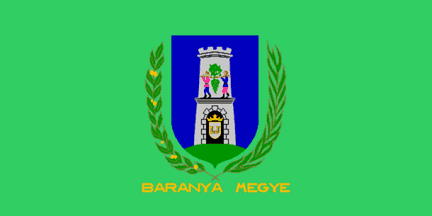
by Mello Luchtenberg, 9 April 2001

Last modified: 2004-12-30 by dov gutterman
Keywords: hungary | baranya | baranja |
Links: FOTW homepage |
search |
disclaimer and copyright |
write us |
mirrors

by Mello Luchtenberg, 9 April 2001
See also:
Municipalities (302 settlements, including 11 towns and 1 city):
City (not part of the county):
Towns:
Res. No.6/1991.(V.31.) of the County about its symbols at <www.bmonk.pecs.hu>.
The inscription is in gold (10th paragraph).
István Molnár, 9 April 2001
The Coat of Arms of Baranya county (Comitatus Baraniensis) was
granted by King Leopold in 1694. The seal was renewed by King
Ferdinand in 1838 and the inscription became Hungarian. Like
Fejér county. The shield was silver originally. The L and I
letters on the small silver shield relate to the King Leopold and
King Joseph (Habsburg). The tower relates to the border [between
Hungary and Croatia or Sclavonia?]. The two people on the tower
is from the Bible (in Hungarian "Józsue és
Kaleb")
The territory of Baranya before the Treaty of Trianon (1920) was
5.177 km2. The treaty is divided it. 1.136 km2 got to Yugoslavia
(now Croatia), 4.0412 stayed in Hungary.
Source: Hoppál Dezso: A történelmi Magyarország
vármegyéinek címerei, Bp. 2001 (The Coat of Arms of the
counties of the historical Hungary)
István Molnár, 9 April 2001
I am not sure to what border the tower might relate. It may be
as Istvan suggested the border of Hungary with Croatia and
Slavonia. It was the Croatian king Tomislav that "pushed
out" the Hungarians "over the Drava river" (Drava
running along the whole south edge of historical Baranya) in
early 10th century, and the border on Drava was then established
as the border among the two nations. However, in the time when
the CoA was granted the two nations were under the same rule and
this then already historical border was maybe not so important.
In 17th century the border was that one against the Turk
(Ottoman) empire. Still it took almost a hunderd years after the
king Leopold granted the arms that the Slavonia to the south was
librated from Turks...
Regarding the two human figures, I believe that they are called
in English Joshua (renambed by Moses to Jehoshua) and Caleb. The
story is probably well known (Numbers 13:1 throgh 13:20), but in
short when the tribes of Israel lead by Moses rewached the Paran
wilderness, Moses sent the two as spies in the land of Kanaan.
They returned with the stories of the rich country (of milk and
honey) but well defended. The standard picturing of the return of
the two is with the vine grape so big that it had to be held by
the two. This exact sceene is also shown in the Baranya Coat of
Arms, I guess in reference to the richness of this region,
comparable to Biblical Land-of-Milk-and-Honey.
Zeljko Heimer, 10 April 2001
In 1694 (when King Leopold granted this Coat of Arms) the
whole territory of Croatia and Slavonia was liberated. The most
of Hungary, northern Serbia, western Bosnia was under Habsburg
military occupation. The Treaty of Karlowitz (1699) joined the
territory of Croatia, Slavonia, Hungary (without the Temesköz -
territory between the Tisza, Maros/Mures and Transylvania) and
Transylvania to the Habsburg empire. Maybe, the tower relate to
the Hungarian-Turkish (new) border.
István Molnár, 10 April 2001

by István Molnár, 27 August 2001
Flying flag at the Conquest Statue, Opusztaszer NHP. Ratio:
3:1. The width of the Coat of Arms is the 1/3 of the width of the
flag. The Coat of Arms is on the 1/3 of the flag's height. The
inscription is gold
István Molnár, 27 August 2001
by.gif)
by István Molnár, 17 April 2001
Geographically, it goes for the same traditional region, which
was afterr WW I divided between Croatia (soon to merge into
Yugoslavian Kingdom) and Hungary. Baranya is
Hungarian spelling , while Baranja is Croatian spelling. There
are actually counties in both countries using that name - Baranya
Megye in HU, and Osjecko-baranjska zupanija
in HR (to use their local names).
Zeljko Heimer, 22 September 1999
The souther part of histrical Baranya county was included
after the World War I in what became latter known as Yugoslavia,
and consquently in Croatia. The current Croatian County of Osijek
and Baranja gears the connection in the name, but also inthe flag
- the tower characteristic for the Baranya coat of arms is set
above the Osijek bridge in the County coat of
arms.
Zeljko Heimer, 9 April 2001